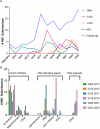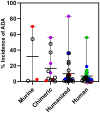Regulatory considerations in the design, development and quality of monoclonal antibodies and related products for the diagnosis and treatment of cancer
- PMID: 38746685
- PMCID: PMC11091260
- DOI: 10.3389/fonc.2024.1379738
Regulatory considerations in the design, development and quality of monoclonal antibodies and related products for the diagnosis and treatment of cancer
Abstract
Over 160 therapeutic and in vivo diagnostic monoclonal antibodies have been approved by the US FDA since the first monoclonal antibody, muromonab, was approved in 1986. Approximately 42% of these approvals were for the treatment or in vivo diagnosis of oncology indications, although some products are no longer marketed. This review will look at the history of monoclonal antibody development and approvals, discuss current antibody-based modalities, regulatory considerations for engineering approaches, critical quality attributes for different modalities, immunogenicity of mAbs across oncology products, and the future directions for development of therapeutic and diagnostic monoclonal antibody-based products.
Keywords: Fc-engineering; antibody drug conjugate; antibody-fusion protein; bispecific antibody; immunogenicity; isotypes; monoclonal antibody; radioimmunoconjugate.
Copyright © 2024 Shapiro.
Conflict of interest statement
The author declares that the research was conducted in the absence of any commercial or financial relationships that could be construed as a potential conflict of interest.
Figures



Similar articles
-
Full-length recombinant antibodies from Escherichia coli: production, characterization, effector function (Fc) engineering, and clinical evaluation.MAbs. 2022 Jan-Dec;14(1):2111748. doi: 10.1080/19420862.2022.2111748. MAbs. 2022. PMID: 36018829 Free PMC article. Review.
-
Considerations for the development of therapeutic monoclonal antibodies.Curr Opin Immunol. 2008 Aug;20(4):493-9. doi: 10.1016/j.coi.2008.05.013. Epub 2008 Jul 2. Curr Opin Immunol. 2008. PMID: 18586093 Review.
-
Monoclonal Antibodies: A Review.Curr Clin Pharmacol. 2018;13(2):85-99. doi: 10.2174/1574884712666170809124728. Curr Clin Pharmacol. 2018. PMID: 28799485 Review.
-
Current strategies in antibody engineering: Fc engineering and pH-dependent antigen binding, bispecific antibodies and antibody drug conjugates.Biotechnol J. 2012 Dec;7(12):1444-50. doi: 10.1002/biot.201200250. Epub 2012 Nov 1. Biotechnol J. 2012. PMID: 23125076 Review.
-
Engineering of monoclonal antibodies and antibody-based fusion proteins: successes and challenges.Expert Opin Biol Ther. 2005 Sep;5 Suppl 1:S15-27. doi: 10.1517/14712598.5.1.s15. Expert Opin Biol Ther. 2005. PMID: 16187937 Review.
Cited by
-
Assessment of mirvetuximab soravtansine immunogenicity in patients with folate receptor alpha-positive ovarian cancer.Bioanalysis. 2024;16(21-22):1101-1113. doi: 10.1080/17576180.2024.2407228. Epub 2024 Oct 8. Bioanalysis. 2024. PMID: 39378056 Free PMC article.
-
Mesenchymal stem cells - the secret agents of cancer immunotherapy: Promises, challenges, and surprising twists.Oncotarget. 2024 Nov 22;15:793-805. doi: 10.18632/oncotarget.28672. Oncotarget. 2024. PMID: 39576660 Free PMC article. Review.
-
Mechanisms, combination therapy, and biomarkers in cancer immunotherapy resistance.Cell Commun Signal. 2024 Jun 19;22(1):338. doi: 10.1186/s12964-024-01711-w. Cell Commun Signal. 2024. PMID: 38898505 Free PMC article. Review.
-
Monoclonal antibodies: From magic bullet to precision weapon.Mol Biomed. 2024 Oct 11;5(1):47. doi: 10.1186/s43556-024-00210-1. Mol Biomed. 2024. PMID: 39390211 Free PMC article. Review.
-
Antibody-Drug Conjugates (ADCs): current and future biopharmaceuticals.J Hematol Oncol. 2025 Apr 30;18(1):51. doi: 10.1186/s13045-025-01704-3. J Hematol Oncol. 2025. PMID: 40307936 Free PMC article. Review.
References
Publication types
LinkOut - more resources
Full Text Sources

